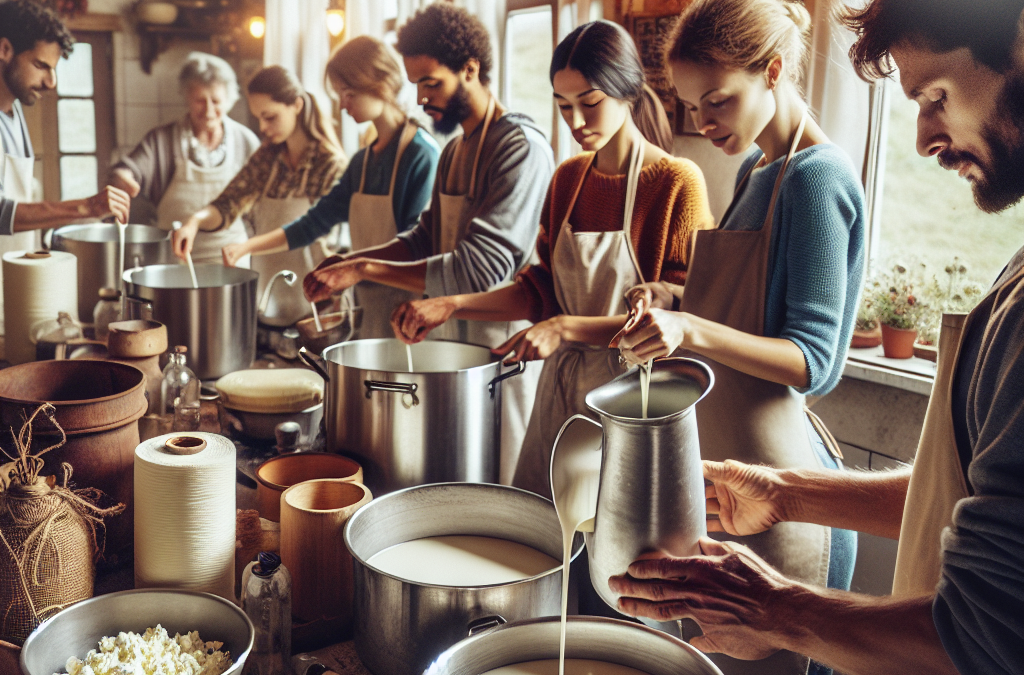Choosing Your Milk: Cow vs. Goat
Understanding the Differences
When it comes to making cheese, the type of milk you choose makes a world of difference. Cow milk is often creamier and has a more subtle flavor, while goat milk can be tangy and rich. Personally, I love the unique character goat milk offers. It’s like a little flavor adventure with every bite!
In my opinion, cow milk is fantastic for beginners, since it’s more forgiving in the cheese-making process. Goat milk, on the other hand, is a bit trickier since it’s more acidic, but oh-so-rewarding if you get it right. Wouldn’t hurt to try both and see what tickles your taste buds more!
Consider the final cheese type you wish to create. Soft cheeses like chèvre are typically made with goat milk, while harder varieties like cheddar are better suited to cow milk. So, if you have a specific cheese in mind, let that guide your milk choice!
Gathering Your Supplies
Essential Tools for Cheese Making
You don’t need a fancy kitchen setup to make cheese at home, but having the right tools can make a big difference. First up, you’ll need a large stainless steel pot. I’ve tried using other materials, but trust me, stainless steel holds heat better and doesn’t react with acids in the milk.
A thermometer is also a must-have. You want to be precise with temperatures, especially when adding cultures or rennet. I’ve learned the hard way that guessing can lead to some interesting yet questionable results!
Don’t forget about cheese molds and a fine cheesecloth! These are vital for shaping your cheese and draining excess whey. Investing in some quality tools will save you a lot of hassle down the line, so I recommend you get the good stuff.
Preparing Your Milk
Pasteurization: A Necessary Step
If you’re using raw milk, one of the first steps is pasteurization. It sounds intimidating, but it really just means heating the milk to kill off any harmful bacteria. I like to take my milk up to about 165°F and hold it for 15 seconds before letting it cool down. It’s super straightforward!
Once your milk is cooled, it’s time for the next step. Depending on the cheese you’re making, you might want to add some cultures at this point to enhance flavors. This is where the magic begins. It’s fascinating how tiny bacteria can create big flavors!
Don’t rush this part. Taking the time to ensure your milk is properly prepared can make or break your cheese-making journey. Believe me, from my experience, it’s much better to take some extra time now than to face a wonky cheese later!
Curdling the Milk
The Art of Curd Formation
This is probably one of the most fun parts of cheese-making! After adding rennet to your milk, you’ll wait for it to curdle. It’s like watching a science experiment unfold right in your kitchen! Depending on the recipe and the milk type, this could take anywhere from 30 minutes to a couple of hours.
Once you see the curds and whey separating, it’s time to cut the curds. I’ve found that smaller cuts yield firmer cheese. So, grab a long knife and dive in! I love the texture contrast of the curds; it’s somewhat therapeutic.
After cutting, you’ll want to gently stir the curds and heat them a bit, which helps them release more whey. Just be cautious not to break the curds too much—there’s an art to it! Too much activity can lead you to a crumbly end product instead of that luscious cheese you’re aiming for.
Draining and Shaping
Getting the Right Texture
Now, once your curds are ready, it’s time to drain them. Pour them into a cheesecloth-lined strainer and let the whey drip away. This is where patience pays off! I usually let mine drain for about an hour, but if you want drier cheese, give it even more time.
Shaping your cheese is also a creative process! You can press it into molds or make little balls, depending on what style you’re going for. I love experimenting with herbs and spices at this stage too; they add that personal touch that makes each batch special.
Once shaped, it’s important to salt your cheese, as it adds flavor and helps preserve it. Just sprinkle some salt on top and make sure to work it in. This is one of those parts where I can’t resist tasting a little along the way. Plus, it’s super satisfying to know you made it all from scratch!
FAQs
1. Can I use store-bought milk for cheese making?
Absolutely! Just make sure it’s not ultra-pasteurized, as that can affect the curdling process. Regular whole milk works just fine for most cheese types.
2. Is cheese-making difficult?
It can seem daunting at first, but practice makes perfect! Start with simple recipes before diving into more complex cheeses. You’ll surprise yourself with how fun it is!
3. Do I need special cultures for cheese-making?
Not always! Some cheeses can be made with just rennet, while others might need specific cultures for flavor. It’s great to do a little research based on the cheese you want to make!
4. How long can I store homemade cheese?
It depends on the type of cheese, but most will last a week or two in the refrigerator. Hard cheeses can last longer if stored properly.
5. Can I mix cow and goat milk for cheese-making?
Yes, you can mix the two! This can create a unique flavor profile. Just keep in mind the different characteristics of each type of milk when adjusting your process.





